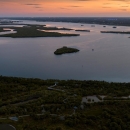Laws and Regulations
Prohibited Activities
- Use of ATVs, UTVs, ORVs, OHVs, snowmobiles, amphibious vehicles, and other off-road vehicles.
- Use of horses, mules, or similar livestock.
- Entering areas posted with No Hunting Zone signs (area surrounding Headquarters).
- The use of screw-in steps, nails, or screw-in devices that attach a tree stand or ladder stand to a tree.
- Use of trail cameras or any electronic or photographic monitoring devices.
- Possession or use of bait.
- Use of flagging, ribbon, reflective tacks, or any other trail marker.
- Overnight camping and open fires.
- Littering.
- Using or possessing alcoholic beverages while hunting.
- Possession of controlled substances.
- Disturbing, harming, or collecting any animal or plant, except legally taken fish and game animals.
- Searching for or collecting shed antlers.
- Disturbing or removing artifacts and historic items.
- Use of unmanned aircraft systems, including drones.
- Target shooting and/or target practice.
Firearms
Persons possessing, transporting, or carrying firearms on National Wildlife Refuge System lands must comply with all provisions of State and local law. Persons may only use (discharge) firearms in accordance with refuge regulations (50 CFR 27.42 and specific refuge regulations in 50 CFR Part 32.)
Hunting Regulations
Hunting is allowed in accordance with Federal regulations governing public use on national wildlife refuges as set forth in Title 50 of the Code of Federal Regulations, State regulations, and the Refuge-specific regulations in this brochure.
Areas Open to Hunting
Hunting Area 1 – There are nine areas included in Hunting Area 1. These areas are open to deer, grouse, moose, partridge, pheasant, and waterfowl (coot, duck, goose, and merganser) hunting in accordance with State regulations, State seasons, and Refuge-specific regulations.
Hunting Area 2 – This area is open to deer, grouse, moose, partridge, pheasant, and turkey hunting in accordance with State regulations, State seasons, and Refuge-specific regulations.
Hunting Area 3 – This area is open to a special late-season hunt that opens the day after the close of the State rifle deer season. Grouse, partridge, and pheasant may be hunted through the end of the State season. Fox may be hunted through March 31.
Area Closed to Hunting
The area surrounding Headquarters is closed to hunting. The area is posted with No Hunting Zone signs.
Equipment
All hunting equipment must be removed from the Refuge at the end of each day.
Fishing Regulations
Fishing is allowed in accordance with Federal regulations governing public use on national wildlife refuges as set forth in Title 50 of the Code of Federal Regulations, State regulations, and the Refuge-specific regulations in this brochure. Boat and Bank Fishing Boat and bank fishing are allowed only on designated areas of the Refuge. Bow fishing and open-water spear fishing are not allowed.
- Signs that say “Public Fishing Area” are posted at each area open to fishing. See the public fishing area descriptions and locations on the map.
- Boat fishing is allowed in Public Fishing Areas 2 and 14 from May 1 through September 30. Only non-motorized boats and boats with electric trolling motors are allowed.
- Bank fishing is allowed in Public Fishing Areas 1-14. Ice Fishing Ice fishing is allowed on all Refuge waters from December 15 until the ice melts. Anglers are cautioned to be aware of thin ice, particularly near water control structures.
- Ice fishing access is walk-in only.
- Only portable ice fishing houses are allowed. Ice fishing houses and other equipment must be removed from the Refuge at the end of each day.
Prohibited Activities
- Use of vehicles on ice.
- Use of ATVs, UTVs, ORVs, OHVs, snowmobiles, amphibious vehicles, and other off-road vehicles.
- Use of horses, mules, or similar livestock.
- Bow fishing and open-water spear fishing.
- Fishing from bridges.
- Entry to or fishing from water control structures.
- Use of permanent fish houses.
- Overnight camping and open fires.
- Littering. Please take your trash with you when you leave the Refuge.
- Entering areas closed to fishing.
- Intoxicated and disorderly conduct.
- Possession of controlled substances.
- Disturbing, harming, or collecting any animal or plant, except legally taken fish and game animals.
- Disturbing or removing artifacts and historic items.

